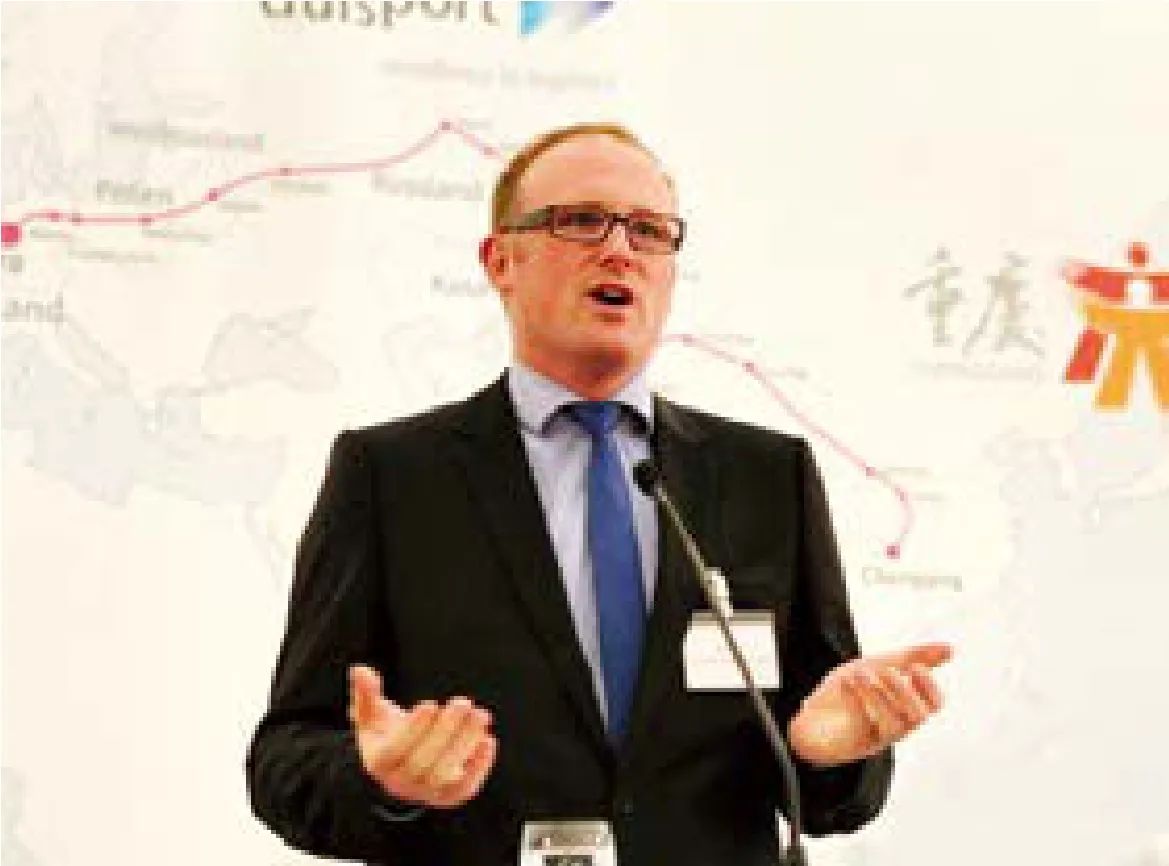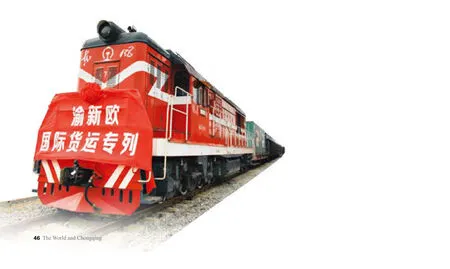杜伊斯堡市市长:选杜伊斯堡为渝新欧终点是正确战略
2015-07-03
杜伊斯堡市市长:选杜伊斯堡为渝新欧终点是正确战略

杜伊斯堡市长苏·林克
【欧洲时报杜伊斯堡报道】 渝新欧铁路是“一带一路”战略中丝绸之路经济带的重要组成部分。自去年3月中国国家主席习近平访问杜伊斯堡港口后,越来越多的中国以及欧洲企业开始对该市开往中国的列车感兴趣。3月6日,记者来到杜伊斯堡市政厅,与市长苏·林克(Sren Link)以及市经济促进局总经理拉尔夫·莫雨勒(Ralf J. Meurer)进行交谈,询问了这条“亚欧大动脉”最新的运营情况。
林克介绍:“渝新欧铁路每周有三班货运列车从重庆发车,至少一趟从杜伊斯堡出发,单程运行时间为14至16天。它的速度比起海运快上一倍,而价格仅为空运的一半,能够有效地连接起充满活力的长江经济带以及现代化的鲁尔经济区。”
莫雨勒说:“从中国来的商品主要为电子产品;而从德国始发的列车则主要运输整车和汽车零配件。一个车皮可以装载两辆整车,一个班列就可以将80辆汽车运往中国。”
关于回程货依然缺乏的问题,林克表示:“一方面我们会与德国企业沟通,让他们了解渝新欧的优势,并选择接受它。我们正在计划将更多的食品运往中国,比如深受中国消费者欢迎的新鲜牛奶,目前还只能依靠空运,未来我们可以利用冷藏集装箱,通过渝新欧,将德国新鲜牛奶送到更多普通中国消费者的餐桌上。另一方面也与中国企业寻求合作,比如重庆有众多外贸食品超市和家居市场,它们都是渝新欧的潜在客户。”
莫雨勒补充到:“渝新欧的运营成本在过去4年已有大幅下降,随着未来需求的增大,班列会增加,运行成本还会进一步下降,势必也会吸引更多的客户,进入一个良性增长期。我们控制运费的目标是向海运看齐。”
为什么选择杜伊斯堡作为渝新欧终点站?林克表示,杜伊斯堡与中国的合作并不是始于渝新欧,而是基于33年的传统友谊。他说:“杜伊斯堡拥有多方面的优势。一,杜伊斯堡1982年便与武汉结成友好城市,不但在经济上,而且在文化、教育、科技等各个方面都与中国保持了良好的合作关系;二,杜伊斯堡地理上是欧洲的中心,在这里可以把货物通过铁路、飞机运到欧洲其他所有地方;三,杜伊斯堡有70多家国际物流巨头在此经营,这为渝新欧筹集回程货提供了绝好的平台。渝新欧铁路作为‘新丝绸之路经济带’的重要一环,是中国的一个战略性项目,杜伊斯堡市以及周边地区的企业都将受惠。选择杜伊斯堡作为渝新欧的终点是一个正确的战略决定。”

去年,习近平主席对德国进行国事访问时特意参观了杜伊斯堡港。林克认为,这无疑对渝新欧铁路、杜伊斯堡市起到了巨大的广告效应,同时释放了一个相当明显的信号:杜伊斯堡市、北威州对于中国投资者而言是一个理想的投资地点。莫雨勒说:“目前共有37家中国企业落户于杜伊斯堡,光去年一年就新入驻7家,其中有两家是物流公司。我们在德国通过各个渠道,比如研讨会、展会与中国企业沟通,同时也会前往中国与他们直接对话。
去年12月份我与市长先生就在重庆,了解当地的产业构成、市场需求,与当地从事外贸的企业进行交流;今年秋天,市长还会前往重庆和武汉,进一步与当地企业建立更加密切的关系。”
2014年中国GDP增长7.4%,2015年将进一步调整到7%。林克认为,中国经济的放缓不会影响到渝新欧铁路的前景。他说:“中国经济保持了20多年高增速,为寻求更高质量的增长,产业结构进行调整,经济有所放缓不可避免。7%对于德国来说依然是一个‘天文数字’。中德经济互补性很强,中国公司对于德国的产品以及技术仍然兴趣十足,尤其是在制造工业和新能源技术领域。我认为中德贸易依然会保持良好的发展势头,渝新欧将会扮演更加重要的角色。渝新欧是一个‘创举’,没有太多的经验可以参考。中方的合作很有诚意也很顺利,当然还有不断完善的空间,比如在班次连接,货物卸载、分转,货物包装说明等方面。”
林克补充到,除了经济往来,文化和艺术交流是联系两国人民最好的纽带。杜伊斯堡拥有东亚研究所、孔子学院,并在多个中小学校开设了中文课程。杜伊斯堡埃森大学里有1500名中国学生就读,是拥有注册中国学生最多的德国大学之一。今年,来自中国的艺术品还将在杜伊斯堡以及周边八个城市的博物馆展出。
林克说:“去年,有多场中国节庆祝活动在杜伊斯堡举办,德国人参与热情也越来越高。几周前,我参加了杜伊斯堡华人举办的春节联欢晚会,感觉非常棒。杜伊斯堡与中国之间还建筑了一条精神和文化上的‘渝新欧’。”
Mayor of Duisburg: It is a Right Strategic Decision to Choose the City as the Terminal of Chongqing-Xinjiang-Europe Railway

【Oushinet reported from Duisburg】Chongqing-Xinjiang-Europe Railway is a major component of the Silk Road Economic Belt as in the Belt and Road initiative. Since Chinese President Xi Jinping visited Duisburg port last March, an increasing number of Chinese and European enterprises begin their interest toward this train bound for China. On March 6, the reporter came to the town hall of Duisburg and conversed with Mayor Sren Link and business promotion agency (GFW) general manager Ralf J. Meurer and asked the lasted operation of this Eurasian artery.
Link introduced that, “there are three freight trains every week departing from Chongqing and at least one from Duisburg on the Chongqing-Xinjiang-Europe line. A single trip takes 14 to 16 days. Besides doubled speed compared with maritime transportation, the rate of this train is only half of air transportation. So it can effectively connect the vibrant Yangtze River Economic Belt and the modern Ruhr Economic Area.”
Meurer said, “Commodities from China are mainly electronic products; while the train starts from Germany mainly carry cars and components. A carriage can load two cars and a whole train can ship 80 cars to China.”
As for the shortage of backhaul cargos, Link said, “on one hand, we will inform German enterprises of advantages of this railway and convince them to use it. We plan to ship more food products to China, such as fresh milk and other beloved products, which are currently still transported by air. In the future, we can utilize refrigerated containers and bring fresh German milk to the dinner table of more average Chinese consumers via this railway. On the other hand, we seek further cooperation with Chinese enterprises, for instance, Chongqing has many imported food supermarkets and home furniture markets, which are all potential customers of the railway.”
Meurer added that, “the operational cost of the railway has gone down quite a lot in the past four years. With more demands in the future, there will be more trains and lower running cost, which in turn willattract more customers and shape a period of sound growth. Our objective is to control the train’s cost to the level of maritime transportation.”
How come we chose Duisburg as the terminal of Chongqing-Xinjiang-Europe Railway? Link explained that the cooperation between Duisburg and China did not start from this railway per se, but our traditional friendship in 33 years. He said, “Duisburg boasts many advantages. One, it became the sister city with Wuhan in 1982 and had maintained sound ties with China not only in economy, but also in culture, education and technology; two, Duisburg is the geographic center of Europe, from where the cargo can be shipped to all European cities through railways and aircrafts; three, with over 70 international logistics tycoons operating here, it offers an excellent platform to organize backhaul cargo for the trains. As a key link of New Silk Road Economic Belt, Chongqing-Xinjiang-Europe Railway is a strategic program of China benefiting Duisburg and enterprises in surrounding areas. Choosing Duisburg as the terminal, therefore, is a correct strategic decision.
Last year, President Xi Jinping visited Duisburg during a state visit to Germany. Link believed this was undoubtedly a huge advertisement to the Chongqing-Xinjiang-Europe Railway and the city itself as well as an explicit signal: Duisburg and Nordrhein-Westfalen at large are ideal investment spots for Chinese investors. Meurer said that, “at present, 37 Chinese enterprises have settled in Duisburg and, last year alone witnessed the entrance of seven new Chinese enterprises, among which two are logistics companies. We communicate with Chinese enterprises through various channels like workshops and expositions and travel to China to talk to them directly.
Last December, our mayor and me went to Chongqing to learn about local industrial mix and market demands and talked to local foreign trade enterprises; this autumn, the mayor will also travel to Chongqing and Wuhan to set up closer ties with local enterprises there.
In 2014, China’s GDP grew by 7.4%, and it will be lowered to 7% in 2015. Link deemed that the slowdown does not affect the outlook of the railway. He said, “China’s economy has maintained a high growth rate for over 20 years. Slower economic growth is inevitable to seek better growth quality and industrial structure adjustment. 7%, however, is still an astronomical figure to Germany. Given strong complementarity between China and Germany, Chinese companies are still very interested in German products and technologies, especially in manufacturing and new energy technologies. I think China-German trade will still maintain a sound momentum, while Chongqing-Xinjiang-Europe Railway will have a bigger part to play. Unprecedented in nature, the railway does not much experience to refer to. The cooperation of China is very sincere and smooth, but we still have room for constant improvement, such as train scheduling, cargo loading, transfer and cargo packaging and description.
Link supplemented that apart from economic ties, culture and art are best links between two peoples. Supported by East Asia Research Institute and Confucius Academy, Duisburg has Chinese classes in many secondary and primary schools. Attended by 1500 Chinese students, Essen University, Duisburg is one of the German universities with the biggest number of registered Chinese students. This year, artworks from China will be exhibited in the museums in Duisburg and the surrounding eight cities.
Link said, “last year, many Chinese festival celebrations were held in Duisburg with increasing participation enthusiasm from the German side. A few weeks ago, I joined the Spring Festival Gala by Chinese people in Duisburg and felt it was awesome. Between Duisburg and China, we have constructed a spiritual and cultural connection too.
